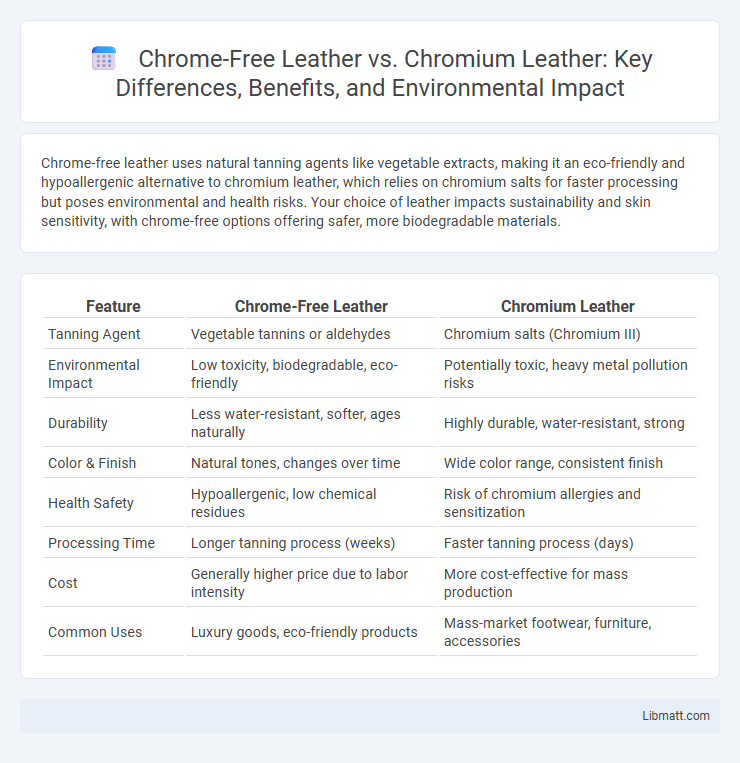Chrome-free leather uses natural tanning agents like vegetable extracts, making it an eco-friendly and hypoallergenic alternative to chromium leather, which relies on chromium salts for faster processing but poses environmental and health risks. Your choice of leather impacts sustainability and skin sensitivity, with chrome-free options offering safer, more biodegradable materials.
Table of Comparison
| Feature | Chrome-Free Leather | Chromium Leather |
|---|---|---|
| Tanning Agent | Vegetable tannins or aldehydes | Chromium salts (Chromium III) |
| Environmental Impact | Low toxicity, biodegradable, eco-friendly | Potentially toxic, heavy metal pollution risks |
| Durability | Less water-resistant, softer, ages naturally | Highly durable, water-resistant, strong |
| Color & Finish | Natural tones, changes over time | Wide color range, consistent finish |
| Health Safety | Hypoallergenic, low chemical residues | Risk of chromium allergies and sensitization |
| Processing Time | Longer tanning process (weeks) | Faster tanning process (days) |
| Cost | Generally higher price due to labor intensity | More cost-effective for mass production |
| Common Uses | Luxury goods, eco-friendly products | Mass-market footwear, furniture, accessories |
Introduction to Leather Tanning Methods
Chrome-free leather, tanned using natural vegetable extracts or synthetic alternatives, avoids heavy metals and offers enhanced environmental sustainability and biodegradability. Chromium leather, the most common tanning method, employs chromium salts to produce durable, water-resistant leather with a faster processing time but poses environmental concerns due to chemical runoff. Understanding these tanning processes highlights trade-offs between ecological impact, leather quality, and production efficiency.
What is Chromium Leather?
Chromium leather is a type of tanned leather treated with chromium salts, primarily chromium III, which offers high durability, flexibility, and resistance to water and heat. This tanning process is widely used in the leather industry because it accelerates production while producing soft and supple leather suitable for footwear, apparel, and upholstery. However, concerns over environmental pollution and toxicity associated with chromium VI residues have led to increased interest in chrome-free alternatives.
What is Chrome-Free Leather?
Chrome-free leather is tanned using natural or synthetic agents without chromium salts, making it an environmentally friendly alternative to traditional chromium leather. This type of leather reduces harmful chemical waste and is often preferred for producing sustainable, hypoallergenic products. Your choice of chrome-free leather supports eco-conscious manufacturing while maintaining durability and quality.
Environmental Impact: Chrome-Free vs. Chromium Leather
Chrome-free leather significantly reduces environmental pollution by eliminating the use of hazardous chromium salts, which are toxic to soil and water ecosystems in conventional chromium leather tanning. Chromium leather tanning consumes vast amounts of water and generates wastewater containing heavy metals, posing severe risks to aquatic life and human health. By contrast, chrome-free leather employs natural tannins or synthetic alternatives that result in lower chemical waste, decreased water contamination, and improved biodegradability, making it a more sustainable and eco-friendly choice in leather production.
Health and Safety Considerations
Chrome-free leather minimizes exposure to toxic heavy metals, reducing risks of skin allergies and respiratory issues often associated with chromium tanning agents. Chromium leather contains hexavalent chromium compounds that can cause dermatitis, allergic reactions, and environmental pollution during production and disposal. Choosing chrome-free leather supports safer manufacturing processes and lowers potential health hazards for both workers and consumers.
Durability and Performance Comparison
Chrome-free leather often exhibits enhanced breathability and natural flexibility, leading to long-lasting comfort and moderate durability suitable for casual use. Chromium leather, treated with chromium salts, provides superior resistance to water, heat, and wear, making it exceptionally durable and ideal for heavy-duty applications. Your choice depends on the intended performance requirements and environmental considerations, with chromium leather offering robust durability and chrome-free leather emphasizing eco-friendly qualities.
Cost Differences Between Chrome-Free and Chromium Leather
Chrome-free leather typically incurs higher production costs due to the use of natural tanning agents like vegetable tannins, which require longer processing times and more labor compared to chromium tanning. Chromium leather remains more cost-effective because chromium salts accelerate the tanning process, resulting in faster production and lower expenses. Your choice between the two will influence both the price and environmental impact of the leather product.
Applications and Industry Preferences
Chrome-free leather is favored in eco-conscious fashion, artisanal goods, and luxury accessories industries due to its reduced environmental impact and hypoallergenic properties. Chromium leather remains dominant in automotive interiors, footwear, and heavy-duty products because of its superior durability, water resistance, and cost-effective tanning process. Sustainable brands increasingly prefer chrome-free leather to meet consumer demand for greener products, while mass production sectors prioritize chromium leather for performance and scalability.
Certifications and Regulatory Standards
Chrome-free leather often meets stringent eco-friendly certifications such as OEKO-TEX Standard 100 and Leather Working Group (LWG) Gold, reflecting its reduced environmental impact and absence of heavy metal contaminants. Chromium leather, while widely certified under standards like ISO 17075 for chemical analysis and REACH compliance for chromium VI restrictions, faces tighter regulatory scrutiny due to chromium's potential toxicity and environmental hazards. Both types must adhere to strict regulations, but chrome-free leather aligns more closely with green chemistry principles and evolving international sustainability standards.
Future Trends in Leather Tanning Technologies
Chrome-free leather tanning technologies are gaining momentum due to growing environmental regulations and consumer demand for sustainable products, utilizing plant-based tannins and biomimetic materials that reduce water usage and toxic waste. Innovations in enzyme-assisted tanning and nanotechnology aim to enhance durability and flexibility of chrome-free leather, positioning it as a viable alternative to traditional chromium tanning. Market forecasts predict accelerated adoption of eco-friendly tanning processes, driven by advancements in circular economy practices and stricter global policies on chromium pollution.
Chrome-free leather vs chromium leather Infographic

 libmatt.com
libmatt.com